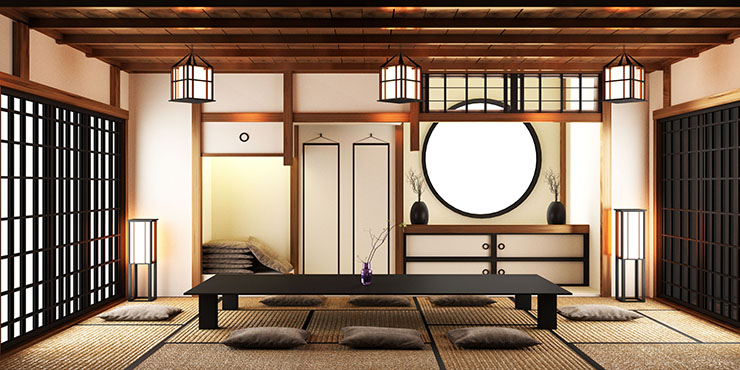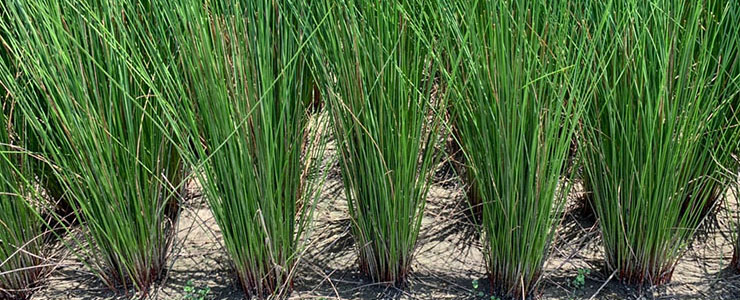TATAMI 畳 & IGUSA 藺草
“TATAMI 畳” is a Japanese traditional floor mat made by natural soft rush, called “IGUSA 藺草”.
A long time ago, Tatami was permitted to be used only by the aristocracy. But as the centuries roll by, especially after expanding the “Tea Ceremony” in the 17th century, Tatami had developed amazingly and penetrated our ordinary life. In the 20th century, almost all houses have had Tatami rooms.

In our culture, we remove our shoes at the entrance before spending barefoot inside the house. You may feel freedom, comfort and relaxation by going without shoes. Also, this habit proves to be effective from a hygiene point of view.

Effects of Tatami
Adjusting humidity and temperature
Tatami is made of the basement, called “Tatami-doko 畳床”, wrapped by mat woven by Igusa, called “Tatami-omote 畳表”.

Igusa is cylindrical stalks, composed of cubic or astrocytic cells. It has a hollow between fibres. And “Tatami-doko” is made of rice straw. Rice straw is also similar structure of Igusa. Both plants possess air-containing spaces, which will control humidity and temperature. One piece of Tatami will absorb around 500cc moisture and desorb it when drying. In Winter, it keeps warm. In Summer, it keeps cool. Tatami will work as a natural insulator and as an air conditioner.
Clean Air
It is proven scientifically that Igusa will make the air cleaner by absorbing formaldehyde and nitrogen dioxide gas. It may be said it is a natural air cleaner.
Sound Absorbency
Igusa and Rice Straw constituting Tatami have so many air-containing spaces between fibres. These air-containing spaces will absorb sounds made by footsteps, TV, audio, etc.
Functioning as a cushion
Tatami has a cushion-like feature that helps you from getting injured. If you happen to fall in Tatami, you will hardly be injured. In addition, Tatami will reduce strain on the feet, back and knees compared to the wooden floor.
Aromatherapy and Deodorant Action
Igusa comprises of several aromatic ingredients like phytoncide. 20% of its ingredients are known to be sourced from the typical raw materials for Aromatherapy “Forest Scent” where the phytoncide resides helping in deodorization, sterilization, reduction of stress hormones, etc.
In addition, Igusa is dyed by natural mad to protect its surface from sunray when dry. By this process, Igusa can keep the green colour freshly and give off a distinct aroma of Tatami. Some ingredients of this aroma have sedating properties. There is a report proven that it will increase attention span and enhance the ability to learn for children.
Tatami is the best choice for health-conscious people.
Recent movement
Tatami-Doko 畳床
“Tatami-doko” has recently been made into mainly wooden and polystyrene board instead of rice straw because rice straw is heavy and needs more professional skill to make. The merit of these new materials is lightweight, easier to make, and resistant to moisture. And it is also as effective as rice straw to use the same for cushion and sound absorbency. However, you can find the high-end Tatami being made by rice straw even now.
Colourful design
Recently, several new designs of Tatami-omote have been introduced.
Igusa can be dyed in several colours and designably woven. You can make a unique Tatami room which would be the only one in the world. Or by incorporating small Tatami goods, you can add spice to your lifestyle.
TRIVIA of Tatami & Igusa
Easily mouldy and mity?
The answer is “No”.
Some people say, Tatami gets easily mouldy and mity. But this is not true.
Tatami is naturally breathable. But, if covered fully by carpet or furniture, the Tatami will not be able to breathe properly. With frequent ventilation and vacuum, the Tatami can breathe well and maintain good condition without getting mouldy or mity.
How to clean?
Please use a dry towel or vacuum cleaner to clean. The point of sweeping is following the grain of a Tatami and vacuuming gently. If possible, it will be also effective to dry your Tatami outside twice a year. If there is no space for drying, it would be effective to ventilate by raising one side of Tatami by a small can.
| Cleaning Methods | |
|---|---|
| Mold | Spray ethanol on mold directly and wipe well with a dry towel. * Do not use chlorine sanitiser! It will change the colour of Tatami. |
| Mite | Vacuum several times, ventilate well by opening windows. Then, if possible, raise up Tatami and dry with the dehumidifier. |
| Coffee / Soy sauce | Wipe by a towel and put some “salt”. When the salt gets wet, scrub tooth brash over the area, then vacuum and wipe with a dry towel. |
| Ink | Make it wet with “milk”, then wipe thoroughly |
| Crayon | Wipe with a dry towel by putting very little “dishwashing cream cleanser” |
| Pen / Marker | Wipe with “polish remover” if its oil-based. If its water-based, wipe by dishwashing cream cleanser. |
Attention!
When wiping Tatami, please use a “dry towel”. If you use a wet towel, please make it dry thoroughly after using it.
Tatami’s size
Each Tatami comes in different sizes. It is too slight a difference to find out at a glance but if you remove them without checking a mark and place them wrongly, they may not match beautifully. When you move Tatami mats, please put marks like number and direction at the back.
Mud
You might be surprised if there is mud on the surface of the new Tatami.
This mud is called “Sendo染土”, which is natural mud and used when drying Igusa. Its role is important. Before drying Igusa, the farmer dipped them into the muddy water. This process is called “Doro-zome泥染”. By this process, Igusa can be dried uniformly, protected by oxidation of chlorophyll and can keep its colour green and fresh.
In addition, this “Doro-zome” raised the ratio of “vanillin” 5 times more than one before its process. Its vanillin has a relaxing effect and is known as “vanilla”, one of the ingredients of aroma or perfume.
* We will remove this mud before export.
New Tatami-omote
Washi-datami 和紙畳
Do you know “Washi 和紙”?
This is a Japanese traditional paper made by “Kozo 楮”, “Mulberry” in English.
Recently, a unique Tatami-omote made by “Washi” was introduced. This kind of Tatami is called “Washi-datami 和紙畳” because it is made as the same structure as Igusa which is like cylindrical stalks, it also works to adjust the moisture of air like “Igusa-datami 藺草畳”.
This “Washi-datami” has some stronger points when compared to “Igusa-datami”.
- Hard to get mould even under extreme conditions.
- High water repellency because of resin coating.
- Strong durability.
- Keeps the colour longer.
We cannot expect the effects of “Cleaning air” and “Aromatherapy and Deodorant action” which is specified in Igusa. However, if you emphasize durability and ease of use, the Washi-datami is also a good choice.
